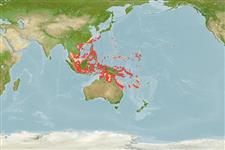分类 / Names
俗名 | 同种异名 | Catalog of Fishes(属, 种) | ITIS | CoL | WoRMS | Cloffa
Teleostei >
Eupercaria/misc (Various families in series Eupercaria) >
Caesionidae (Fusiliers) > Caesioninae
Etymology: Pterocaesio: Greek, pteron = wing, fin + Latin, caesius = blue grey (Ref. 45335).
More on author: Bleeker.
Environment: milieu / climate zone / depth range / distribution range
生态学
海洋 礁区鱼类; 非迁移的; 深度上下限 0 - 50 m (Ref. 402). 热带; 30°N - 24°S, 97°E - 171°E (Ref. 402)
Indo-Wes Pacific.
Report from Réunion (Ref. 4517) is probably a misidentification of Pterocaesio marri.
西太平洋: 印度尼西亚与澳洲到新加勒多尼亚西部, 北至日本南部。 最近记录自诺福克岛 (参考文献 8881) 与东加。 (参考文献 53797) 可能是一个 Pterocaesio marri 的错误鉴定的来自留尼旺岛 (参考文献 4517) 的报告.
Length at first maturity / 大小 / 重量 / 年龄
Maturity: Lm 21.3 range ? - ? cm
Max length : 30.0 cm TL 雄鱼/尚未辨别雌雄; (Ref. 402)
背棘 (总数) : 10; 背的软条 (总数) : 14 - 16; 臀棘: 3; 臀鳍软条: 11 - 12. Body blue to greenish dorsally, white ventrally. With two thin yellow to orange lines; lower line mostly just below lateral line. Black tips on caudal fin (Ref. 48636). 4-5 scales on cheek; 24-31 predorsal scales; scaled dorsal and anal fins. Upper peduncular scale rows usually 12 or 13 (11-14); lower peduncular scale rows usually 16 or 17 (16-18). A broad process on ventrolateral surface of basioccipital for attachment of Baudelot's ligament, extending ventrally beyond a horizontal with condyle's rim, adjacent to condyle. Post maxillary with 2 processes; posterior end of maxilla tapered (Ref. 1723). Head length 3.0-3.5 in SL; body depth 3.5-4.1 in SL (Ref. 90102).
身体蓝色到呈绿色的背面, 腹侧白色的。 有两个细的黄色到橘色的线; 低的线大部份在侧线正下方。 在尾鳍上的黑色的顶端.(参考文献 48636) 在颊上的 4-5 鳞片; 24-31个前背的鳞片; 覆有鳞片的背鳍与臀鳍。 上柄的鳞片列通常 12 或 13;(11-14) 下柄的鳞片列通常 16 或 17.(16-18) 在 Baudelot 的结带的附着的基枕骨的腹侧表面方面的一个宽的突起, 腹地延伸超过一与骨阜的边缘,邻近骨阜保持水平。 上颌骨有 2个突起; 颚骨的后端成锥形。
Found in coastal areas, primarily around coral reefs (Ref. 402), turning bright red (Ref. 48636). Feed on zooplankton in midwater aggregations (Ref. 402). Oviparous, with numerous, small pelagic eggs (Ref. 402).
发现于沿岸区域了, 主要地珊瑚礁 (参考文献 402) 的周围, 变鲜红色.(参考文献 48636) 在中层水域群集中吃浮游动物。 (参考文献 402) 卵生的, 有很多的, 小型大洋性鱼类卵.(参考文献 402)
Life cycle and mating behavior
Maturities | 繁殖 | Spawnings | Egg(s) | Fecundities | 仔鱼
Mating behavior observed from an aquarium include six distinguishable patterns: 1) up and down swimming; 2) courtship; 3) rushing; 4) pair spawning; 5) sperm release by sneakers; and 6) post spawning (Ref. 37529).
At nearly sunset, the usual quiet pack of fish give way to spawners swimming at the surface. A male selects a female and initiates pecking and pushing of the female's abdomen with his snout. At the rushing stage, the male pushed the female forward, and the couple began to swim in a semicircle in short bursts while other 10-15 sneakers within the school joined in. The initial couple then released eggs and sperm at the surface with their abdomens facing one another. Some of the leading sneakers may also release sperm at the same spot where the initial couple spawned. After spawning, the pair with the sneakers return to the school (Ref. 37529).西太平洋: 印度尼西亚与澳洲到新加勒多尼亚西部, 北至日本南部。 最近记录自诺福克岛 (参考文献 8881) 与东加。 (参考文献 53797) 可能是一个 Pterocaesio marri 的错误鉴定的来自留尼旺岛 (参考文献 4517) 的报告.
Carpenter, K.E., 1987. Revision of the Indo-Pacific fish family Caesionidae (Lutjanoidea), with descriptions of five new species. Indo-Pac. Fish. (15):56 p. (Ref. 1723)
人类利用
渔业: 商业性
工具
特别资料
下载 XML
网络资源
Estimates based on models
Preferred temperature (Ref.
123201): 24.7 - 29, mean 28 °C (based on 702 cells).
Phylogenetic diversity index (Ref.
82804): PD
50 = 0.5002 [Uniqueness, from 0.5 = low to 2.0 = high].
Bayesian length-weight: a=0.01148 (0.00627 - 0.02102), b=3.16 (3.00 - 3.32), in cm total length, based on LWR estimates for this species & Genus-body shape (Ref.
93245).
营养阶层 (Ref.
69278): 3.4 ±0.48 se; based on food items.
回复力 (Ref.
120179): 中等的, 族群倍增时间最少 1.4 - 4.4年 (tm=2-3).
Fishing Vulnerability (Ref.
59153): Low vulnerability (20 of 100).
Nutrients (Ref.
124155): Calcium = 55.6 [35.8, 81.2] mg/100g; Iron = 0.675 [0.441, 0.997] mg/100g; Protein = 18.8 [17.8, 19.7] %; Omega3 = 0.14 [0.10, 0.20] g/100g; Selenium = 28.6 [17.5, 48.8] μg/100g; VitaminA = 147 [57, 378] μg/100g; Zinc = 1.25 [0.91, 1.66] mg/100g (wet weight);
